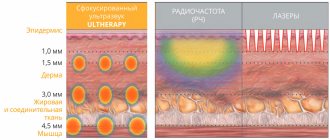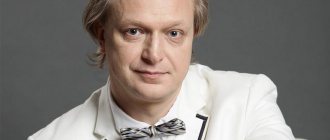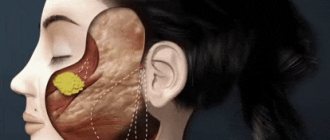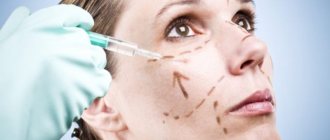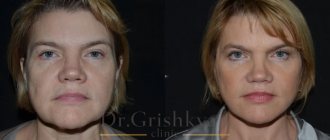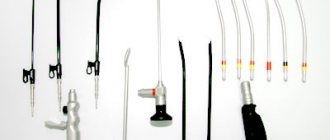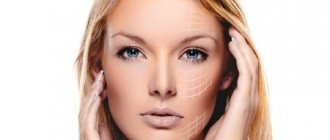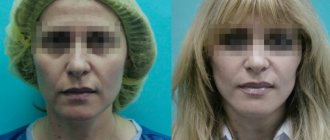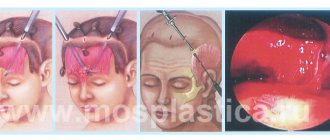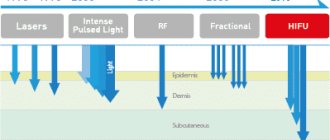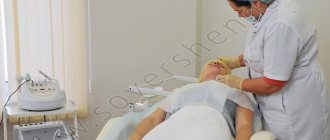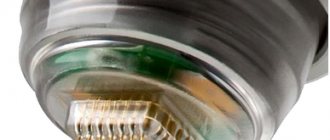MU S T -lifting
is
a modern minimally invasive plastic surgery to lift the face and/or neck using elastic thread-implants installed through discreet incisions in the temples and/or in the fold behind the ear according to the method of Dr. Scherer (
DR.SCHERER ).
Advantages of MUST-lifting
- The result
is radical rejuvenation, maintaining a natural appearance; - Practically safe
- there is no risk of damage to large vessels and facial nerves; - Recovery
– the rehabilitation period lasts from 2 to 4 weeks; - The effect
lasts for 10 years; - Quick
– short operation lasting no more than 1 hour; - Without anesthesia
- intravenous sedation in combination with local anesthesia; - Outpatient
– the patient can return home on the same day.
About Dr. Scherer
Max-Adam Scherer is the author of a new method of minimally invasive surgical facelift MUST-lifting, founder of the Clinic of High Aesthetic Medicine, plastic surgeon, specialist in minimally invasive rejuvenation techniques, dermatologist and cosmetologist.
Dr. Sherer completed two residencies: in plastic surgery at the B.V. Petrovsky and in dermatovenerology at Moscow State Medical University named after I.M. Sechenov. Even during his studies, he was convinced that the main part of his work would be the correction of age-related changes. At that time, the West began to pay more and more attention to the possibilities of reducing the invasiveness of surgical interventions. The successive acquisition of two specialties gave him the opportunity to take a broader look at each of them and allowed him in the future to develop his own approach to the selection and implementation of procedures and operations, which he called INVISIBLE TOUCH ™ (English: “invisible touch”). The essence of this concept is to achieve the maximum rejuvenating effect while completely preserving the naturalness of facial expressions, natural harmony and individuality of features, and so that the very fact of the intervention remains completely unnoticeable.
The results of his clinical practice convincingly demonstrate that the synthesis of minimally invasive cosmetology and plastic surgery makes it possible to achieve not only significant, but also the most natural rejuvenation.
Spring Thread
It’s one thing to read scientific articles about facial rejuvenation methods, and another thing to hear an opinion about the procedures from a specialist. After all, the opinion of a living person is much more informative and interesting than dry facts and figures. That is why we decided to interview one of the best specialists in our country. It was at his instigation that the 3D lifting method began to be used in Russia for anti-aging procedures. We decided to find out what it was, but we got a little carried away, and we ended up talking about rejuvenation in general.
Our interlocutor, Max-Adam Scherer, is a plastic surgeon, dermatovenerologist, specialist in minimally invasive rejuvenation surgery, and cosmetologist. In this doctor, two specialists are closely intertwined. On the one hand, he knows what acne is, how to cure it or how to make a face mask, on the other hand, he can easily perform SMAS lifting or plastic surgery on the eyelids. He is sure that if you can raise eyebrows with Botox, then there is no need to drag the patient to surgery.
— You were the first in Russia to introduce the 3D lifting method, tell us a little about it.
— At one time, I noticed that filler is not just a filler, but a material thanks to which a surgeon can sculpt completely new facial shapes, or restore them. Previously, they didn’t think about fillers from this side. The drugs were used very one-sidedly: there are three types of hyaluronic acid, and they exist in order to fill certain specific areas.
Over time, the face not only droops, it becomes “empty” inside, due to the fact that the fat layers become thinner and the face seems to “deflate.” If you look at the face more closely, it becomes clear where these voids are located. And the simplest thing that can be done is to use materials that, when administered, give a good volume - volumetric preparations. This is 3D lifting - volumetric injection rejuvenation and face lifting through the rational introduction of such materials. They replenish the deficiency of their own cells, due to this the face is tightened and the internal empty spaces are filled.
- Straightaway? Or does it take time to complete this?
— 60% immediately, the rest within 2 weeks. And the doctor’s skill lies precisely in the competent calculation of the required amount of the drug. Ideally, the material should be introduced so that it is not noticeable to others. Just once, and the patient became 5-10 years younger - this is a real 3D lifting.
— What drugs do you use for this?
— Now I can do 3D lifting in different ways. And adipose tissue, and various materials, and calcium hydroxyapatite, and hyaluronic acid. And even in combination with threads or botulinum toxin. For me, this is a whole complex of rejuvenation. Somewhere you need to put threads, in some areas you need to do volumetric correction, somewhere you need to perform botulinum therapy, and perhaps add plastic surgery. For example, surgically tighten the eyelids, strengthen the oval of the face with threads, fill the missing volumes of the face with fat cells, and finally “turn off” unwanted facial expressions with Botox.
- Since you mentioned threads, let's talk a little about them. Explain to our readers what is the difference between bio-threads and implant threads?
When they say threads, this is 95% associated with cosmetic mesothreads, which provide a cosmetic effect - improve complexion, give skin elasticity or level cellulite. Cosmetic threads are designed to solve skin problems. They do not require conduction anesthesia, any incisions, or sedation. Cosmetic threads provide a cosmetic effect.
Thread implants are those that are located in tissues with a lifetime guarantee. Bio-threads are absorbable; when placed, they provide a slight lifting, rejuvenating and strengthening effect of the skin, and when dissolved they maintain this effect. You should not expect a pronounced tightening from them. For example, mesothreads, their main word is “meso”, that is, they provide a mesotherapeutic effect. And with implants you can raise an eyebrow or the corner of your mouth, tighten your jowls or remove a double chin.
That is, bio-threads are recommended for preventive purposes, and implants for the purpose of correcting age-related ptosis. A noticeable and lasting lifting effect can only be achieved with implant threads.
— What do you mean for preventive purposes? It turns out that biothreads should be used by young people, and implants only by older patients?
- No. Even at 45 years old, a woman may not have ptosis. In this case, you can get by with bio-threads. Or, on the contrary, it could be a fairly young girl, for example, 22 years old, but she has lost a lot of weight. Or she gave birth, but the birth was not easy - she gained a lot of weight, she had swelling. Here you will need thread implants. Here's another example. Let’s take a very old patient with excess skin, but her skin is very thin and there is practically no fat layer. In this case, it is impossible to work with threads. You can tighten it up, but what should you do with the excess skin? Only excise surgically.
Therefore, it is very important to choose the right patient for whom threads can be placed, so that there is a good and long-term result. It all depends on genetics, on how a person treats his face, how he takes care of his skin.
Sometimes a patient comes and says: “I want thread!” And you understand that she clearly doesn’t need threads. Or, on the contrary, he declares: “Do anything, just don’t use threads - they don’t work for me.” Why don't they work? Apparently she already had a negative experience. But threads can be shown to her and can provide an excellent result. Perhaps she just needed thread implants, not bio threads.
— We’ve sorted out the lower age limit, but is there an upper age limit for installing threads?
- It all depends on the circumstances. If, for example, a 60-year-old woman comes in with a complicated medical history: blood pressure, diabetes mellitus, etc., then taking her for a major operation is risky for the body. However, you can do something that definitely improves her appearance, but, most likely, not to the extent that she expects.
— Is it possible to install thread implants, and for preventive purposes add, for example, mesothreads once in a while? Will this be prevention?
— Initially, different layers of skin are involved. If we are talking about bio-threads that stimulate, then they are installed either in the dermis or a little deeper - in the subcutaneous fat. As they dissolve, they thicken the skin and make it elastic - that is, they act on the skin. And if we take thread implants, then we are talking about deep layers. The smas (superficial muscular-aponeuric system) and fatty tissue are affected in order to precisely tighten - to create tension due to the action of the threads themselves.
— Is it possible to re-lift the face when there are already thread implants? For example, the threads were installed, they worked successfully for 5 years, and gravity took its toll - the face fell off again. So what should I do? Should I take it out and install new ones? Or should these already installed ones be tightened up somehow?
— It all depends on the methodology. I practice a technique where I put threads through small incisions and fix them so that I can replace them at any time. Five years have passed... I can replace them or tighten them again.
— Are there any contraindications for installing threads?
- Certainly. As with any invasive procedure. In a good way, before placing threads, you need to undergo examinations: donate blood, undergo an ECG and fluorography.
— You work with both threads and injections. What do you like best?
- I can’t say which I like better. These are all medications, all different materials and it is important to select them so that they provide a natural result. I don’t like hyper-correction on my face, and I work in the “natural look” tradition.
— By what criteria do you choose to place threads or give injections?
— These are complementary techniques. They go together. I can, for example, inject hyaluronic acid, botulinum toxin or my own fat cells in one procedure, and at the same time tighten the oval of the face with threads.
— Who is better to contact for a facelift – a cosmetologist or a plastic surgeon? And what factors need to be considered when choosing a specialist?
— For a tightening, go to a surgeon, for “collagen” you can run to a cosmetologist. Now there are specialists in minimally invasive rejuvenation techniques. This is a discipline at the intersection of cosmetology and plastic surgery. Surgery is becoming more and more minimally invasive and is replacing classical approaches, which is logical. Tools, techniques, materials, diagnostics, etc. are being developed.
If the surgeon is trained to work with threads, he will do an excellent lifting, but if not, get ready for the fact that he will drag you into some ancient surgical methods, more aggressive. Perhaps they are needed, perhaps not yet. For initial manifestations of ptosis, for local fat deposits in the lower third of the face, this is a surgical technique combined with a minimally invasive one. For example, I do liposuction of the “double” chin, “jowls”, and immediately lay a thread so that they do not sag again.
If you want to buy cosmetics, you go to a cosmetologist. If you want something more, when cosmetologists can no longer cope, you need other approaches: for some it is plastic surgery, for others thread implants are suitable. But sometimes it is easier to offer the patient the option of an endoscopic facelift than to insert threads. Today, the possibilities of surgical thread lifting are truly impressive.
— And the last thing you can wish for our readers?
— I would like to wish our readers to consult more with various specialists before deciding on anything. Each patient must find “his” surgeon.
- Thank you.
Related materials:
No similar pages were found.
The main area of work of Dr. Scherer
The main direction is anti-age, from anti-aging surgeries and minimally invasive injection procedures to cosmeceutical programs that counteract skin aging. Therefore, it works mainly on the face and neck area. In his practice, he uses a set of techniques, including his own developments, aimed at effectively solving age-related problems. Dr. Scherer has been introducing the most modern techniques and methods of rejuvenation into his practice for several years in a row, with the goal of reducing the invasiveness of interventions, which can significantly reduce risks and shorten rehabilitation time.
Features of the surgical method of facial rejuvenation MUST-lifting
In short, MUST-lifting is a full-fledged facelift through small incisions in the temporal region, providing absolutely natural rejuvenation and quick rehabilitation. “Mandatory” lifting is something that absolutely needs to be done (from the English MUST - a verb expressing the need to do something).
MUST-lifting is an abbreviation that stands for “Minimal Undermining Suspension Technique” and is translated from English as “a facelift operation with minimal detachment and implantation with Spring Thread implant threads.” In April 2022, in Monaco, Max-Adam Scherer successfully presented his method at a meeting within the 15th World Congress of Aesthetic and Anti-Aging Medicine.
The developed method is the basis of two well-known techniques (facelift with plication of the SMAS (muscular aponeurotic layer) and thread lifting using Spring
Thread®
. The MUST-lifting operation provides an effective tightening of the contours of the face and the area under the lower jaw while maintaining the naturalness of features and individuality of appearance.
During this operation, the muscular aponeurotic layer (SMAS) is carefully sutured and tightened through plication (gathering into folds) using an atraumatic guide without the risk of damaging important anatomical structures, and then fixed with Spring
Thread®
. "spring threads") This ensures a firm face for many years. During the operation, soft tissue lifting is carried out along the vertical vector, that is, in the direction directly opposite to the action of gravity, which avoids the “flat face” effect that occurs after a traditional circular lift, as well as sometimes deformation of the lips, nostrils and earlobes.
As a rule, after a MUST lift, no hematomas are formed, and the patient can be sent home on the same day, and after a traditional circular lift, the patient remains in the clinic overnight. The advantage of MUST lifting is the minimal duration of the rehabilitation period: after 2-4 weeks, patients can return to their normal lifestyle.
Eye rejuvenation from Max-Adam Scherer
— How to avoid the “round” eye effect after eyelid surgery?
Dr. Scherer: There is a category of patients with weakened canthus tone; during eyelid correction, they need to tighten the corner of the eyes (canthopexy). If this is not done, you can get eyelid inversion to one degree or another, and, as a result, a symptom of operated “round” eyes. I use minimally invasive strengthening of the canthal ligament by suturing it from the inside. I never cut it, but only strengthen it in this way, due to which the canthal ligament contracts and pulls the corner of the eye upward. This maneuver gives the eyes a slight almond shape, thus avoiding the effect of a “round” eye after surgery.
— Do you perform plastic surgery of the orbicularis oculi muscle during correction?
Dr. Scherer: Let me clarify that the classic method of blepharoplasty involves resection of the muscle. I follow the latest trends in plastic surgery of the eyelids - preservation of the orbicularis oculi muscle
, I rarely use resection. Also, I do not always remove all fat packets, but use their movement and subsequent fixation to eliminate skeletonization of the orbital edge. To treat hernias of the upper and lower eyelids, I often use the transconjunctival approach.
— They say that the transconjunctival approach for eyelid surgery is not suitable for everyone...
Dr. Scherer: Traditionally, the transconjunctival approach is used in cases where there is no excess skin of the lower eyelids. However, I use this approach in most cases as it is less invasive. At the same time, I carefully remove excess skin using the pinch technique (pinch - pinch off in English)
. Hernias are removed from the inside without affecting the orbicularis oculi muscle. If necessary, canthopexy is performed. This approach to eyelid correction significantly reduces the rehabilitation period.
— Do you use lipofilling for eyelid surgery?
Dr. Scherer: The lipofilling technique was improved many years ago by Sydney Coleman, so lipofilling in its classical form has long been out of date due to its short-lived effect and complications. Today I am using a new and effective way of working with adipose tissue - fatgrafting.
– restoration of missing adipose tissue. During the procedure, not large fragments of adipose tissue, which were previously used in lipofilling, are introduced into the designated areas, but small grafts obtained in a special way, due to which the survival rate is up to 80%, which naturally affects the duration of the correction result.
—Are you redistributing fat tissue?
Dr. Scherer: In some cases, I redistribute infraorbital hernias to correct pronounced tear troughs, and in other cases, I remove and use fatgrafting. Everything is always very individual.
—Where do you get fat from?
Dr. Scherer: I focus on the wishes of the patients. Basically, everyone wants to remove excess from the so-called fat “traps”. These are accumulations of fat cells that can form in different parts of the body and face. Most often it is the stomach or knees. However, this procedure does not require a lot of material.
Fat grafting necessarily accompanies oculoplasty of the upper and lower eyelids, because replenishment of adipose tissue is very rejuvenating, eliminating age-related contouring of the bony edge of the orbit.
— Do you add plasma (PRP) to the fat for better engraftment?
Dr. Scherer: I used to enrich fat grafts with PRP, but not today. Since the process of isolating PRP uses an anticoagulant: either citrate or heparin. The latter do not shorten rehabilitation, and sometimes even cause additional swelling, hematomas and bleeding after surgery. From my practice, the duration of the result after fat grafting is proportional to the correct gentle technique of collecting, processing and introducing fat grafts than to the addition of plasma (PRP).
Features of the operation
When performing a MUST face lift, all manipulations are carried out through small incisions hidden in the temples. Deep detachment of the SMAS (muscular aponeurotic layer) is not necessary, and soft tissue tightening is carried out by gathering the muscular frame of the face (SMAS plication) with implant threads. Securing the threads in the scalp of the temple is simple and does not require the use of additional devices. This lifting technique gives a double rejuvenation effect:
- surgical
(tightening the muscle layer ensures clarity of the oval of the face), - thread
(smoothing facial wrinkles, nasolabial folds and corners of the mouth).
The vector of the lift thanks to the thread frame is as natural as possible, which eliminates the undesirable effect of a flat “operated” face, an increase in the length of the mouth and widening of the nostrils. Through a zigzag incision at the temples, excess skin is removed, and therefore the visibility of the scar in the future is absolutely excluded, even if the woman prefers a short haircut, since it “disappears” in the hair. An important advantage is the absence of an incision in front of the auricle, which automatically eliminates the problems of a classic facelift, such as deformation of the tragus and earlobe, which can always be used to determine the fact of a facelift.
At the end of the operation, the thread-implants are carefully fixed to the temporal fascia and therefore can be easily removed or replaced with new ones after a long period of time (after 10 years). The operation ends with the removal of excess skin and the application of a cosmetic suture, which is hidden in the scalp of the temples.
Neck rejuvenation
Beauty Medicine Tags:
Elena Zhenina:
Hello! The program “Anti-age medicine” is on air. I am with you, Elena Zhenina. And the guest of my today’s program is Max-Adam Scherer, a plastic surgeon, a specialist in minimally invasive rejuvenation surgery, a dermatologist, a cosmetologist and a specialist in thread techniques. And the topic of our today’s program is the neck, what we can do with it, how we can improve its appearance, what techniques exist today, and what both a cosmetologist and a plastic surgeon have in their arsenal. Now, just before the program, we discussed a little about what is more important – the eyes or the neck. And for many, many years in plastic surgery and cosmetology the focus was on the eyes. They always said that you need to remove wrinkles, open your eyes slightly, and then the woman will seem younger. But we have come to the conclusion that this is not so. Today, the canons of beauty are slightly different. Tell me which ones?
Max-Adam Scherer:
Good morning everyone! Of course, the neck is a trend, because now there are many techniques that allow you to quickly and easily achieve the desired clear oval of the face and this angle (cervical-chin angle) in the shortest possible time. My opinion, as a specialist, is that rejuvenation of the lower third of the oval of the face is the most important thing in order to immediately get a Wow effect. After all, in fact, there are many minimally invasive techniques, that is, these are thread solutions and modern surgical solutions in situations where you need to take a radical approach to this issue. They work, it's cool!
Elena Zhenina:
In my work, if we are talking about the work of a cosmetologist, I like the trinity of methods when neurotoxins are used first - we will say this because we have already moved away from the word botulinum toxins and moved on to neurotoxins - and after that lipolytic drugs that reduce fat packets, because that with age they move, and our face shape changes. And the final thing to all this is thread techniques that even out the contour and make it clearer. Of course, there is still a small point in the form of fillers, which can be used to lengthen the chin a little, to make the cheekbone angle more clear, but these are masterly improvements that not everyone needs, not everyone needs. But these 3 procedures that I mentioned give a very good effect, I would even say good, and at any age, and they get better. Of course, this is not plastic surgery, this is not minimally invasive surgery, these are not the thread techniques that you know. And most importantly, in all of this we cannot form this cervical-mental angle; here we will not succeed.
Max-Adam Scherer:
In plastic surgery, the same trinity is the same, only it is more objective. Of course, instead of lipolytic drugs, liposuction is used, that is, what we are talking about the cervical-mental angle are softer solutions. This is, of course, a muscle tightening. And in three places where we relax the platysma bundles with minimally invasive injections, in surgical practice we suppress them. In essence, we are doing the same thing, only more objectively. Here we are simply talking about a long-lasting effect, including more obvious results, because injection cosmetology and thread solutions allow you to create a soft, but obvious and beautiful result. In those situations when something more is needed, then, of course, there is surgery with the same triune approach.
Elena Zhenina:
It is very good when the methods coincide precisely in the concept, because using the concept, we arrive at the result we want to achieve. It's just either brighter or softer, depending on who chooses what. But I would like to analyze all these points in more detail: when do we do platysmoplasty, when do we use thread technologies, when can we limit ourselves to the same neurotoxins? Here you are, as a specialist, as a doctor already practicing, with a lot of experience and with your own original methods, because you have an excellent method of neuromesolifting, and it also works great on the platysma and on the oval. So let's start with the easy ones and move on to the hard ones.
Max-Adam Scherer:
I'd like to start with the heavy stuff, of course, but oh well. The point is that first we talk about injections, because injections are prevention. Here we look at the patient, what is the condition of his neck and décolleté, is there a tendency to accumulate fatty tissue (the so-called double chin) and already choose some soft paths. Today there are mesopreparations, biorevitalizants, there are even fillers with included peptides that have a lipolytic effect and at the same time affect the skin - this is a breakthrough, this is cool! That is, the quality of the skin improves, fat deposits in this area are reduced, and, as a rule, we see the effect even after a couple of procedures. This is the newest thing that allows patients to receive prevention.
The second story is that if some minor changes begin to occur with age, they can be removed. When we talk about botulinum toxins, we naturally relax the platysma bundles, which are also a manifestation of age. In fact, this is very interesting, because the subcutaneous muscle of the neck is slender in its youth, but over time it develops cords and some irregularities. Why? Because it is a thin subcutaneous muscle that moves down along with the skin and creates these strands inside. That is, there is no hypertrophy there, as is commonly believed, the muscle itself simply moves more medially. And all our approaches are aimed at preventing this process.
Elena Zhenina:
Is it possible to somehow slow down the process of shifting this muscle, or does gravitational ptosis work the same on everyone?
Max-Adam Scherer:
Can we cancel gravity, friends?
Elena Zhenina:
We can if we stand upside down...
Max-Adam Scherer:
Entropy takes its toll, so this can be prevented first prophylactically, with the help of threads (resorbable, or I most often like elastic threads, non-resorbable) and in some situations, of course, surgery is what prevents it.
Elena Zhenina:
What about massages, hardware techniques, biorevitalizants with a high content of biologically active substances?
Max-Adam Scherer:
Here the quality of the skin is good skin, which means good muscle.
Elena Zhenina:
Good blood supply to muscles...
Max-Adam Scherer:
There is one caveat here. The fact is that there are patients who, from an early age, tend to accumulate fatty tissue, and they do not have this clear cervical-chin oval.
Elena Zhenina:
There are such patients - young, already somewhere after 25, 27 this becomes noticeable, and we can assume that by the age of 40 we will get problems.
Max-Adam Scherer:
I can say it happens before. There are always patients who say: “You know, doctor, I’ve never had anything like this, I always dream about it, can you?” I say: “We can!” This is true.
Elena Zhenina:
Even if it has never happened, can we still do it?
Max-Adam Scherer:
Yes we can do it. This is where manipulations with the muscle itself are carried out, usually surgical or minimally invasive, like I do. This is the complete removal of fatty tissue using liposuction and redistribution of platysma bundles. They are cut somewhere, hemmed somewhere, somewhere I put them on elastic threads, because the neck is a very mobile structure, so it is very important that the threads here are elastic, otherwise the movement of the head on threads that are inelastic causes patient discomfort.
The neck is a very mobile structure, so it is very important that the threads here are elastic, otherwise moving the head on threads that are inelastic causes discomfort in the patient.
Elena Zhenina:
Of course, it will be both painful and difficult.
Max-Adam Scherer:
And a short-term result, because the movement muscle must work all the time.
Elena Zhenina:
I agree with you that you need to either have surgery or use elastic threads.
Max-Adam Scherer:
Here's the anatomy. But I want to say that changing this anatomy is real, it’s fast, it’s practiced, and such a clear angle can be obtained. We now see a large number of star patients who tend to be overweight, and it may sound rude, but this tendency to be overweight is now also a kind of new trend. And if we pay attention, they don’t have any double chins and so on, they have absolutely clear facial contours. It is clear that this is some kind of magic, because it should not be like this, that is, by nature there should be something there. At least if you lower your head a little, but it’s not there. What is this? These are precisely the technologies that allow you to remove all this and clearly model the lower third of the face.
Elena Zhenina:
Please tell us how this operation goes, how long it takes and what the rehabilitation process is like after it.
Max-Adam Scherer:
There are 2 modifications of this operation. One is called the MUST neck lift - this is my modification, it is for young patients who do not have excess skin, for whom the neck muscle can simply be remodeled.
Elena Zhenina:
At what age is this operation available, if we are talking about young patients?
Max-Adam Scherer:
This may be after 20 years. If the patient understands that she has a hereditary-constitutional problem and it needs to be solved radically, this is done. Small incisions are made, this is a surgical procedure under sedation, that is, the patient is put to sleep, and the muscle is modeled by installing fairly strong elastic threads intramuscularly, as a result of which this muscle changes its position and a clear cervical-mental angle is drawn. Liposuction is done first, that is, this weight that pulls the neck down is also aspirated, that is, removed using a puncture. That is, this is a manipulation with very fast rehabilitation and a quick effect. In fact, after a week everything is perfect - no bruises, nothing remains. I believe that such a procedure for young patients today is a masterly story of restoration and solution to such problems.
For patients who have an age component or excess skin, a zigzag incision is made, which is hidden in the scalp in such a way that even if you lift the hair and hide it in a braid, in a ponytail, this incision will never be visible. This excess skin is removed through this zigzag incision. And manipulations with the neck and fatty tissue are actually the same as for young patients who do not have an age-related component.
Elena Zhenina:
Does this operation affect any other structures, or is it exclusively platysmoplasty?
Max-Adam Scherer:
No, this turns out to be a lateral platysmaplasty in combination with a medial one, that is, sometimes it is necessary for patients who have an age-related component to provide an application, that is, suturing two layers of platysma along the medial part, that is, to make longer incisions under the chin in order to remodel this platism. But this is in patients with an age-related component. I do all this less and less often, because through the lateral approach, that is, a small incision hidden behind the ear, zigzag in the scalp, disappears, is completely invisible and gives a good result.
Elena Zhenina:
Can we say that the scars are practically invisible and nothing remains?
Max-Adam Scherer:
No, there's nothing left.
Elena Zhenina:
Moreover, now there are polishings.
Max-Adam Scherer:
In the event that some pathological scars form in patients prone to this, you can involve therapeutic cosmetology and smooth it all out. But the main idea is that the muscle is elastic, it is fixed on elastic threads, that is, these are thread-implants - not what we are used to seeing in cosmetology, but this is a silicone elastic implant that acts as a new ligament that is strong, elastic holds the muscle. And therefore we get new contours thanks to this fixation. Therefore, while moving, it’s all absolutely comfortable, it doesn’t disrupt any dynamics, and it will be very natural.
Elena Zhenina:
What happens to excess skin? Because there are not only problems with platysma, but also the tissue itself is quite atonic, with a lot of wrinkles, with deep folds.
Max-Adam Scherer:
Here's a question. If I can remove them through a zigzag cut, that is, this is the main part of the neck that is visible, it will all go away, stretch, excess skin will go away by removal, the skin will be clear. But the quality of the skin, in the sense of the décolleté, the not entirely visible part of the décolleté, needs to be improved, usually through non-injection technologies. I really like the various collagen stimulators in this area - this is Radiesse special...
Elena Zhenina:
Mesoradiesse do you mean?
Max-Adam Scherer:
Yes, Mesoradiesse (off-label introduction). I like the drug Sculptra - also a very special protocol for this area.
Elena Zhenina:
Also mesotechnics?
Max-Adam Scherer:
In a high dilution, because these drugs provide what hyaluronic acid does not provide, that is, they produce collagen, which is lost over time, so good, elastic, firm skin is achieved. Hyaluronic acid also has a place, because biorevitalization with various options (with peptides, with prolonged hydration) also gives a boost effect. Such a beautiful, youthful neckline and slender neck are an alliance of injection techniques and modern surgery.
Elena Zhenina:
Maybe there are some additional interesting hardware techniques that help us in the neck and décolleté area? Do you have anything you love (besides intimal plastic surgery)?
Max-Adam Scherer:
I look at them all the time and see therapeutic effects, of course, but for me it’s prevention.
Elena Zhenina:
This is also an opinion, this is your experience, and it is very valuable. Why am I asking you this? Because every doctor has his own tricks, and he is committed to what he does. And why do we have such a huge number of plastic surgeons, and they are all in demand? Because everyone has their own story, which they bring to life in order to get the result that is inherent to them. And it really works. Even taking the same neurotoxins, they all work with the same drugs, they all work, it would seem, using the same method, but what matters is the dilution of the drug, the depth of the injection, and the application of these points.
Max-Adam Scherer:
If we are talking about the neuromesolifting technique that I introduced, in fact, it has been implemented very widely, I did not even expect that there would be such a resonance. That is, my idea was that hyaluronic acid, vitamin complexes and botulinum toxins together should work great. And after I proposed this technique, the technique is that botulinum toxin is actually combined in one syringe with hyaluronic acid. And if we are talking about the neck and décolleté, then this is the most fantastic result using the injection technique and neck lift. It is not comparable to surgery, but it is much better than just a single drug.
And the second idea behind neuromesolifting is continuous administration, that is, botulinum toxin is administered intradermally (it gives its effects of beautiful skin) and intramuscularly (it gives a powerful muscle relaxant effect). Therefore, this procedure is performed once every 4 months and gives a lasting result. All colleagues who are inspired by this technique get great results. Because there were many opponents, many skeptics: “Doctor Scherer, what did you mix so much?..” I say: “And look at the results of the mix...”
Elena Zhenina:
But this only means that botulinum toxins are a living drug that you need to feel and understand what it is and how to work with it. And it’s impossible to explain. I was just recently at another seminar on training on neurotoxins in the lower third, and the doctors asked: “How much to inject here, how much here?” Colleagues, I can’t tell you how much, because if we put a bottle of vodka in front of two different people (one thin - the other fat, one hungry - the other well-fed, one has one metabolism - the other another), the result will always be different. You must know this, feel, understand, this comes only with experience - with work experience and, probably, with the experience of experiences that you make on those people who agree to experience them. Therefore, of course, this is a very subtle point, but it works. I wanted to ask you about the now fashionable procedure - the removal of Bisha's lumps.
Max-Adam Scherer:
I knew you'd ask about this. I'm in the opposing camp. In general, I am one of the first people who began to write about this in the available literature - that Bish’s lumps do not need to be removed, they do not give the result that everyone writes about. And besides, as is generally accepted in world plastic surgery, Bish’s lumps have a rather negative effect over time. And this is due to anatomy, because the spur of the fat body, which is called the lump of Bichat, is a longer structure that comes from the temporal region, the middle zone and so on, so removing the lumps over time leads to sagging over time , so to speak, is falling, the middle zone is falling.
Elena Zhenina:
So we can say that gravitational ptosis will happen faster?
Max-Adam Scherer:
And more obvious. Therefore, this is a ridiculous, stupid procedure that is very commercialized in the sense that it is a simple manipulation, anyone can do it. And this is how it is performed - by cosmetologists who are not afraid to make an incision from the mucous membrane, perhaps without having certain skills for this, dentists and plastic surgeons. This is a technique that appeared at the junction of the belief that retracted cheeks are cool. But in order to get such a clear triangular contour in those patients who want to get it and, as a rule, do not have it, removing Bisha’s lumps does not lead to this. Therefore, you can read reviews on the Internet - a huge number of patients who are dissatisfied and disappointed with this result.
I can say more that after 10 years they will have other problems, and they will not really associate it with the fact that they once removed the lumps. That is, most of them did the procedure, but there was no effect. I did the procedure - swelling, healing, pain, if the removal of Bish's lumps was accompanied by some kind of problem, but there was no effect. The effect will come later, but it will be negative. It's my opinion. And in order to get this wonderful effect, here people who are prone to such fleshy cheeks need surgery. But patients who have little knowledge on this topic (sorry for the jargon) have drugs that are lipolytic substances that inject into the subcutaneous tissue and thin it. And we are not talking about Bish’s lumps, which are located deeper.
Elena Zhenina:
And there are some other tricks in the lower third that are used to visually change the shape of the face - this is implantation of the chin, this can be fillers based on hyaluronic acid, or it can be implants.
Max-Adam Scherer:
Yes, silicone facial implants are very cool. But in the same way, I always offer patients a demo version, that is, I use dense hyaluronic acid to simulate the effect for a while. That is, an increase in the projection of the chin, when the chin becomes sharper, its shape changes. Moreover, for both women and men it always looks very beautiful, it is very trendy, very directly unusually beautiful, especially if the chin protuberance is not pronounced. And the most interesting thing is that the visual focus of the nose goes away, because, as a rule, with an unexpressed chin protrusion (with an inexpressive chin), the focus goes to the nose, and it seems that the nose is large. And we simply forget about the harmony of the chin and the angles of the lower jaw. That's why I always pay attention to this. I use fairly dense hyaluronic acid. The classic is Restylane SubQ (bone injection). It doesn’t hurt, now these drugs containing lidocaine, it’s a matter of seconds. But the face immediately changes, absolutely changes!
Elena Zhenina:
Do all chins undergo such correction, or is there still some form in which correction with hyaluronic acid is pointless and useless?
Max-Adam Scherer:
I would divide it into 2 aspects here. There is an age factor. Here, as we know, the process of bone resorption occurs, irregularities appear in the oval area of the face, and the chin becomes flatter. This is kind of an age-related aspect, so here we can recommend almost every second person to have such an injection to improve the oval of the face, to rejuvenate it, to restore the profile. And young patients who do not have a pronounced chin protrusion, in order to make their face more harmonious, are given injections of hyaluronic acid.
Elena Zhenina:
Are we still following the parameters of the golden ratio?
Max-Adam Scherer:
I don't know, I don't agree. We are now following such parameters that it is generally incomprehensible. The fashion, fashion and beauty industry dictates its own standards, and young people come to me and show me some photographs from social networks, some stars, some bloggers, celebrities, and so on.
Elena Zhenina:
I would like lips, please, like Reshetova’s...
Max-Adam Scherer:
Well, there is complete confusion there. What we are saying about the oval of the face and the chin, for example, in female beauty a strong-willed chin and emphasized angles of the lower jaw, which have always been the prerogative of male beauty, have become very fashionable. And, on the contrary, we see some smooth masculine lines.
Elena Zhenina:
Although it’s strange, because the trend in the East is they remove the corners of the lower jaw, they make the face smaller in this area so that it looks more harmonious.
Max-Adam Scherer:
These bone fragments are cut down.
Elena Zhenina:
Either they cut it down, or they also use botulinum toxins to reduce the volume a little.
Max-Adam Scherer:
Yes, in any way, from such bone surgery to the use of botulinum toxins in high doses. And if we are talking about the Asian face, then both men and women prefer, it seems to me, a more baby face, that is, these are children's and youthful faces.
Elena Zhenina:
Is the European trend now unfashionable?
Max-Adam Scherer:
If we are talking about the lower third, the European trend in both men and women is more brutal chins and angles of the lower jaw, that is, a direct sculpture: retracted cheeks, high cheekbones, quite hypertrophied, pronounced angles of the lower jaw and a sharp chin.
Elena Zhenina:
You just said “not full, but high.” How and by what means is this achieved?
Max-Adam Scherer:
This is achieved simply by other techniques, that's all. That is, if you can make cheekbones, heart-shaped cheeks, when you make a soft, pointed chin and such lush cheeks, that’s one story. But the second story, on the contrary, has a sharp chin and high, sharp cheekbones. They probably look more aggressive, more sculptural, that is, they take on a face that I don’t even know how to express...
Elena Zhenina:
Some choppiness, I would say.
Max-Adam Scherer:
Yes, but initially this was the prerogative of more male sculpture. Now, in mild forms, it is becoming female. And, as we see, these are models, photo models, fashion models, this mixture is now very popular among them. It all comes from there, from the catwalk, from fashion. I want to say that they find very interesting faces - this is, as a rule, a mixture of different nationalities, when very interesting faces appear, memorable, non-standard. And here the rule of the golden ratio does not work. But this becomes a trend, someone saw an interesting face, an unusual face, individuality, charisma, naturally, someone begins to like it more than they like it, they begin to copy it.
Elena Zhenina:
The outer third is not only the neck, not only the angle of the chin and the angle of the jaw, but also the lips and the orbicularis oris muscle. What can you suggest in this situation, what to emphasize, what to advise?
Max-Adam Scherer:
If we return to trends again, then now there are 2 concepts of beauty fighting each other. One concept is naturalness, that is, so that it looks extremely natural, no feeling of correction - just smooth, fresh, moisturized, bright lips that are ageless. And the second concept is this kind of sculpture, this is a popular print that you simply cannot help but pay attention to. These are 2 concepts, and people are ready to defend either this or that version in relation to themselves.
Elena Zhenina:
Of course, this is achieved with drugs based on hyaluronic acid.
Max-Adam Scherer:
Moreover, both are achieved with preparations based on hyaluronic acid.
Elena Zhenina:
The same, or still different?
Max-Adam Scherer:
Different techniques. Here I have a technique called Optiklips. Optiklips is a method of combining two drugs, two types of hyaluronic acid, which previously everyone said should not be mixed.
Elena Zhenina:
And with one drug you work on the contour, and with the other drug you work on soft tissues?
Max-Adam Scherer:
Well, yes. This Optiklips technique assumes that one drug is injected very superficially, and it is very soft, and thus there are many small injections. The lips seem to be filled, they acquire an optical effect, that is, hyaluronic acid reflects light, moisturizes well, and gives a bright color to the lips. And another type of hyaluronic acid sculpts the shape (restoring the contour, giving a small volume). And in fact, Optiklips is just the first trend (very natural, very beautiful, very fresh, but there is no feeling of the presence of artificiality, there is no artificial moment). And the second is 3D modeling of the shape of the lips in different volumes, using different techniques. Do you want Angelina Jolie in the prime of her beauty, or Scarlett Johansen - different lip shapes, but expressive and sexy.
Optiklips suggests that one product is injected very superficially and is very soft, while another type of hyaluronic acid sculpts the shape.
Elena Zhenina:
What we have just discussed is the winter option. And we also have summer when we wear revealing things (sundresses, dresses, in the end, even the neckline), and we want this zone to be marked too. What can we do with it, what do we have in our arsenal? Let's probably have 2 options: to quickly put ourselves in order (wow, right away, there is some effect, let it be bright, but short-lived), and what procedures are there that we can use regularly, constantly in order to should this area be maintained in good condition?
Max-Adam Scherer:
I have neuromesolifting - this is the answer to almost all questions, it’s done right away, it’s done regularly every 4 months, it’s always very beautiful, because it’s a combination of botulinum toxins and hyaluronic acid, which works on the brightness, color, hydration and slimness of the skin.
Elena Zhenina:
What if there are already deep wrinkles there?
Max-Adam Scherer:
Then recovery therapy. I always pay attention to breasts, that is, lush, heavier with age, breasts, one way or another, are associated with problems in the décolleté. Here you need to understand whether something needs to be done with the breasts, whether some kind of breast lift is needed, because the notorious wrinkles that appear on the décolleté are mostly the breasts, this is the first thing.
The second story is photodamage (how much sun there was, how aggressive it is to the skin, what phototype). I have already said that I really love drugs that are collagen inducers. In such situations, I propose to restore the collagen frame using injection techniques.
Elena Zhenina:
How often are these procedures performed? And what is the rehabilitation process?
Max-Adam Scherer:
Here too you can divide into 3 options. The first option is the most natural and autologous - using your own adipose tissue. If there is a fat trap (places where fat cells accumulate), you don’t want them to be there, it’s ideal to take them from there and insert them into the décolleté, into the upper pole, respectively, of the mammary glands - an amazing procedure, it will require rehabilitation, but nothing like that.
Elena Zhenina:
Here, bioreinforcement is most likely the most convenient thing to do with cannulas.
Max-Adam Scherer:
These are cannulas, but this is an aggressive technique; after all, the grafting of adipose tissue will differ from the injection of material. Here you need the cells to take root, and they will have an effect. Very cool, very cool, but you need to count on rehabilitation, and yet this is outpatient surgery, that is, the removal of adipose tissue is an element of liposuction. A radical but absolutely natural approach. The neckline takes on a very lush, so to speak, effect. That is, the skin has been changed and the presentation is very beautiful, that you want to touch, because it is smooth and very cool. But rehabilitation.
If we take collagen inducers, for example, Sculptra, then it will require 3 to 4 sessions per year in order to achieve a stable result. And the fastest effect is Radiesse Solutions, this is MesoRadiesse, because calcium hydroxyapatite itself slightly brightens this area. I like this for patients with photodamage because I notice that somehow the age spots lighten, and this elastosis goes away beautifully with Radiesse.
Elena Zhenina:
And, of course, the effect of light reflection is obtained, as a result, the area will look more advantageous after this procedure.
Max-Adam Scherer:
Yes. But, I repeat, there are working methods here that are very cool, but here you definitely need an examination, you cannot say in absentia: “You need this, you need this, you need this...”
Elena Zhenina:
I can’t help but ask you one question that patients very often ask: “Doctor, please tell me, if I do facial exercises, what effect will I get?”
Max-Adam Scherer:
I will say negative, and I’m ready to prove this method to all specialists and trainers, foaming at the mouth. If this is a young patient, and this is done for the purpose of prevention, then, probably, while this is being done, there is an effect, and it is good, stable. If the patient has an age component, then this is absolutely impossible to do, because some other muscle bundles are being pumped up.
Elena Zhenina:
I completely agree with you.
Max-Adam Scherer:
And then they are so resistant, because the patient wants to quickly remove it by injecting, for example, the same botulinum toxin, but this does not work quickly. Here I am categorically against it!
Elena Zhenina:
I agree with you. One girl of mine performed the same procedure for quite a long time in order to make a clearer oval. As a result, there was a slight tightening here (in the middle), but the increase in the platysma muscles led to a drooping of the oval of the face, and this was a noticeable story.
Max-Adam Scherer:
Here you need to understand that through physical exercise we will tone the muscle, but we will not return it to its place, because it falls, it moves, it has a higher fixation in a young state, over time it simply relaxes. It will not be possible to return it using such methods, and making it more powerful, heavier, more obvious is easy, so this does not help here, there is no need to do this.
Elena Zhenina:
Better is a good old massage, which improves blood circulation and gives at least some tone, even for a short period of time.
Max-Adam Scherer:
And pleasure.
Elena Zhenina:
And pleasure, because everything we talked about before cannot be called pleasure. But the result that brings pleasure after this torment is, of course, beautiful. It is very good that now there is such a variety of methods that you can choose for yourself not only based on pricing policy, but also according to some of your inner beliefs, because many are afraid to undergo surgery or inject the same neurotoxin. Although I don’t understand why this question: “Doctor, I read that it reaches the brain...” always baffles me, because I don’t understand how this is connected? And it’s good that this exists, that we can do all this and use it. Nowadays, rehabilitation issues are no longer as pressing as they were before, and the healing process occurs faster (with proper preparation and proper management of the patient). And, probably, due to the fact that there are no these temperature changes, due to the fact that everyone already understands that when you have done something, you can take antibiotics for 2-3 days, and everything will recover faster. Therefore, there is no need to be afraid, you should always come to the doctor and ask for an opinion, advice, get recommendations and boldly move towards the result that you want to see in the mirror, and that your doctor can offer you. Thank you very much for coming today through these endless traffic jams!
Max-Adam Scherer:
Thank you!
Elena Zhenina:
Thank you for sharing what you can do today. I think that everyone found it interesting, useful, and everyone came away with something that they wanted to see, or do, or feel. Let me remind you that our guest was Max-Adam Scherer. I was with you, Elena Zhenina. We talked about the neck today. See you again on air! Goodbye!
Max-Adam Scherer:
Goodbye!
Visible scars and marks after the intervention
During the operation, Dr. Scherer makes a small incision - the horizontal part is located in the scalp of the temporal region, and the vertical part does not even reach the tragus, respectively, the tragus and earlobe remain in place and are not deformed. The threads take on the tissue tension caused by gravity and the movement of facial muscles, unload the healing suture and, thus, provide the best conditions for the formation of a cosmetic, almost invisible scar.
As a rule, patients who come to the Clinic of High Aesthetic Medicine are in harmony with their age. For them, the years they have lived are a wealth of life experience that clearly reveals their individuality, therefore, they do not need those changes in appearance that hide their individuality. The purpose of their coming to the clinic is to remove signs of fatigue associated with aging, remain attractive, be in good shape, and look younger.
MUST-lifting. Max-Adam Scherer
In April of this year, the 15th World Congress of Aesthetic and Anti-Aging Medicine took place in Monaco. We met with the founder of the Clinic of High Aesthetic Medicine, plastic surgeon and dermatocosmetologist, Max-Adam Scherer, who presented his original MUST-lifting
.
Max-Adam, are you both a plastic surgeon and a dermatocosmetologist?
— Yes, I completed two residencies: in dermatovenerology at Moscow State Medical University named after I.M. Sechenov and plastic surgery at the Russian Scientific Center for Surgery named after B.V. Petrovsky. Even while receiving my medical education, I clearly realized that the main direction in my future work would be the fight against age-related changes. During that period, minimally invasive techniques in surgery began to gain momentum in developed countries. Immediately after finishing my first residency in dermatology and cosmetology, I moved on to studying plastic surgery, which in the future allowed me to create my own approach, which I called “invisible touch” based on the intersection of minimally invasive cosmetology and plastic surgery. Based on my clinical practice, I can confidently assure that only in the symbiosis of these two areas of aesthetic medicine are the most natural rejuvenation results achieved.
What plastic surgeries do you perform?
As I already said, my main direction is anti-age in the broad sense:
from anti-aging surgeries and minimally invasive procedures, to cosmeceutical programs in the fight against skin aging. Therefore, I mainly work with the face and neck area. At the core of my practice, I use a set of techniques, including my own, aimed at solving age-related problems. Thanks to modern technologies, most of them are minimally invasive, which significantly reduces risks, rehabilitation time, and also minimizes the visibility of surgical intervention.
Facial rejuvenation includes many different techniques. Which of them do you use in your practice?
In my work, I am used to relying on the wishes of my patients, and they are often the most demanding people who have high demands on the quality of the services provided. They value their time very much; comfort and safety are important to them. My patients need special treatment, in a private environment in the clinic. They definitely do not want to be suspected by others of carrying out any interventions and have noticeable scars. At the same time, the chosen correction method or operation must preserve or even emphasize their individuality.
Traditional surgical approaches to facelifts involve interventions with fairly long incisions in front of and behind the ear, and, of course, they leave scars of exactly the same size. The approaches of all methods known today are identical - the specialist needs to gain access to the SMAS - the membrane that deforms with age - in order to tighten it. That is why there is a need for such an extended skin incision. And if owners of long hair can hide traces of surgery under their hairstyle, then with a short haircut, for example, a man’s haircut, noticeable scars pose a special problem. Another important point is that none of the patients wants or can afford a recovery period of several months, and also expose themselves to the risk associated with a “deep” SMAS detachment. Therefore, a few years ago I thought about how to make a facelift an operation that I want to do.
But not all facial problems can be solved through small accesses; there are very “neglected” faces. . .
As a rule, patients who come to my clinic are in harmony with their age. For them, years are a direct reflection of life experience and individuality, so they do not need obvious transformations in appearance. The goal is to remove signs of fatigue associated with aging, remain sexually attractive, be in good shape, look younger, but at the same time not look “operated” in the eyes of others. That is, their desires are extremely clear - to look decent and attractive at their age.
If we speak sincerely, then, of course, there is a category of patients who no longer fall into the category of “timely applicants.” Many of those who have suddenly lost weight have suffered a stressful situation or a serious illness, but even in such cases there are solutions.
What is special about your method of facial rejuvenation?
In short, MUST-lifting is a full-fledged facelift through a small incision in the temples with an absolutely natural rejuvenation effect and quick rehabilitation. This is the lifting that everyone dreams of doing, the mandatory lifting, the one that absolutely needs to be done (from the English must - must).
Thanks to the simultaneous use of two full-fledged techniques that I have adapted: tightening the muscular aponeurotic layer with stitching layers (SMAS plication) and lifting with elastic threads-implants, a powerful tightening of the contour of the face and neck is ensured while preserving the natural contours.
There are a number of nuances: during the operation, the muscular aponeurotic layer (SMAS) is carefully plicated - a kind of “assembly” is assembled using an atraumatic conductor, so damage to important anatomical structures is completely excluded. The “assemblies” of soft tissue obtained in this way are fixed with elastic Spring Thread® implant threads, which provide natural support for the oval of the face and neck for many years. During the operation, tissue distribution is carried out along the natural tension lines of the face, which avoids the “flat face” effect and deformation of the shape of the lips and nostrils, which sometimes occur in previous generation techniques.
As a rule, the operation does not leave behind hematomas, and the patient goes home on the day of the operation, which is a great advantage compared to a traditional circular lift, which usually requires a daily stay in the clinic. However, as well as the minimum recovery time - after 2-4 weeks, patients return to a full-fledged lifestyle.
Have you given a name to this method?
The method is called MUST-lifting, where the abbreviation MUST stands for minimal undermining suspension technique
translated from English as a facelift operation with a minimal peeling effect using a supporting technique with elastic
Spring Thread® implant threads
.
Was this technique completely developed by you?
European colleagues use a similar technique to lift the cheeks and cheekbones, but I slightly modified it and used it to correct the shape of the face and neck.
Do the Spring Trade threads you use not dissolve?
Spring Trade are flexible elastic thread implants. With this method, there is no point in using absorbable threads, otherwise the effect of the tightening will disappear after a few months. The advantageous difference between these threads and conventional suture material is their unique ability to stretch and at the same time powerful fixation in soft tissues, that is, providing shock absorption in facial expressions and head movements.
How long does the effect last after applying your MUST-lifting modification?
The rejuvenating effect lasts about 10-15 years.
How many packs of Spring Trade threads are needed to carry out such a correction?
It all depends on the indications and variation of the operation. A maximum of 2 packages can be used in the neck lift option along with the neck.
What is the price for such rejuvenation in your clinic?
Cost of MUST lifting: face - 177,000 rubles, face + neck - 295,000 rubles. Without the cost of thread implants.
How long does rehabilitation take?
On average, rehabilitation lasts 2-3 weeks. In rare cases, the period may increase to 1 month.
Will the scar still be visible?
During the operation, I make a small zigzag incision in the scalp of the temporal region, not reaching the tragus; accordingly, the tragus and earlobe remain in place, and their deformation does not occur. Since the tension is taken over by the threads, the skin heals without tension, and a cosmetic scar is formed, which is almost invisible.
What anesthesia do you use for this correction?
The operation is recommended to be performed under sedation. A 24-hour hospital stay after a facelift is not required.
Thanks for the conversation, doctor!
For additional information and individual consultation on the MUST lifting operation, please contact the Clinic of High Aesthetic Medicine at the address: Moscow, Bolshoi Karetny Lane 24, building 2, Tsvetnoy Boulevard metro station, tel.: 8 (495) 150-69-96
drscherer.ru
About Spring Thread® implant threads (Spring Thread)
Spring
Thread® (Spring Thread)
are the only elastic, non-absorbable thread implants with small bidirectional teeth along the entire length. These teeth provide reliable and gentle fixation of the implant threads in soft tissues; the polyester base gives the implant threads high strength and flexibility, and the hypoallergenic silicone shell provides elasticity and safety of alignment in tissues. All this ensures comfort for patients. The threads are implanted along the vectors of gravity, which makes it possible to “return” the soft tissues to their previous young position and preserve the individuality of the patient’s features. Thanks to a unique combination of characteristics, implanted threads reliably support tightened soft tissues, are comfortable and safe for patients, and guarantee long-lasting results.
